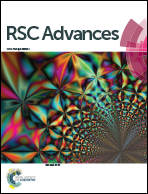Osteoblast compatibility of minerals substituted hydroxyapatite reinforced poly(sorbitol sebacate adipate) nanocomposites for bone tissue application†
Abstract
The main focus of this investigation is to explore minerals (M) substituted hydroxyapatite (M-HAP) as reinforcing agents to strengthen poly(sorbitol sebacate adipate) (PSSA), a biodegradable polymer for soft and hard tissue applications while not considerably compromising their biocompatibility. PSSA strengthened with different weight percentage of M-HAP nanocomposite was synthesized using a microwave irradiation technique. The functional groups within the nanocomposites were determined by Fourier transform infrared (FT-IR) spectroscopic and X-ray diffraction (XRD) analysis. X-ray photoelectron spectroscopy (XPS) further showed the interface interaction between the M-HAP and PSSA. The morphological and elemental analysis was obtained from field emission-scanning microscopy (FE-SEM) equipped with energy-dispersive X-ray (EDX) spectroscopic analysis and transmission electron microscopy (TEM). The addition of M-HAP greatly increased the mechanical, thermal properties and improved the protein adsorption ability. In vitro bioactivity in simulated body fluid (SBF) experiment and human osteosarcoma MG63 (HOS MG63) cells proliferated on the M-HAP/PSSA shows that the nanocomposite has sensible cell biocompatibility. All these observations suggest that the M-HAP/PSSA nanocomposites will be promising biomaterials for bone tissue engineering applications.


 Please wait while we load your content...
Please wait while we load your content...